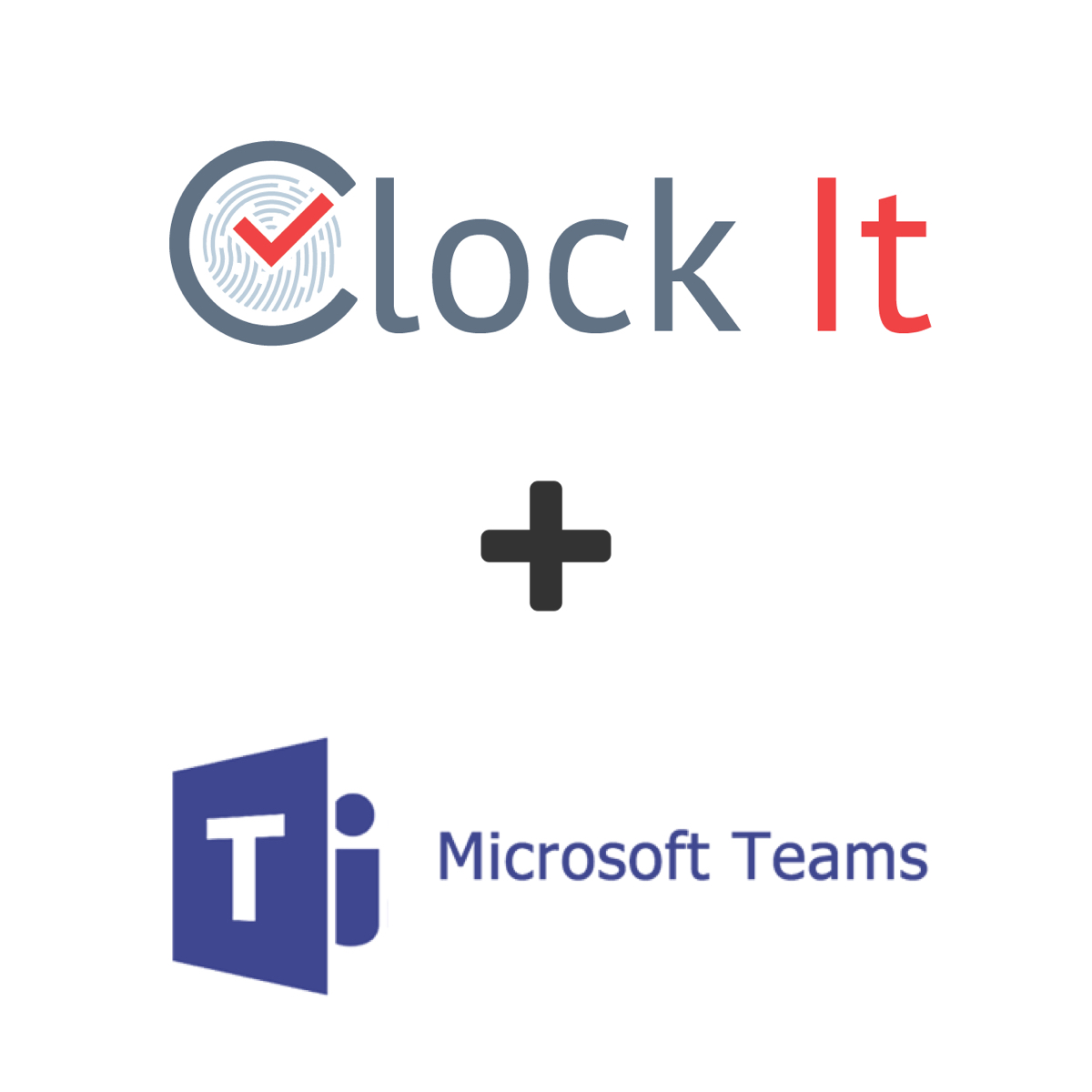
03 Aug Easily Track Employees in Microsoft Teams
How to track employees in Microsoft Teams?
ClockIt’s Microsoft Teams integration revolutionizes workforce management by enabling employers to effortlessly track clock-in and clock-out times directly within the Teams interface. Our integration transforms Teams into a centralized hub for both collaboration and time tracking, reducing the need for multiple platforms and streamlining your operations.
Now, employees can clock in or out, take breaks, or go on lunch, all from within the Microsoft Teams environment they are already familiar with. Managers gain real-time insights into workforce productivity and attendance without needing to switch platforms, resulting in accurate payroll, reduced administrative workload, and greater operational efficiency. Experience the convenience and efficiency of integrated time tracking with ClockIt and Microsoft Teams. Enhance your workplace productivity today!
What is Microsoft Teams?
Microsoft Teams is a unified communication and collaboration platform that combines persistent workplace chat, video meetings, file storage (including collaboration on files), and application integration. The service is built on Office 365 Groups, and it integrates with Microsoft’s Office 365 productivity suite and features extensions that can integrate with non-Microsoft products as well.
Microsoft Teams supports threading in conversations, which allows users to reply to specific messages directly, aiding in more coherent discussions. It also supports public and private groups and teams. In addition to these text-based interactions, Teams supports video calling and screen sharing, making it a comprehensive tool for remote collaboration.
What is a time clock integration with teams?
A time clock integration with Microsoft Teams is a software feature that enables the tracking of employee work hours directly within the Teams environment. It essentially brings the functions of a traditional time clock into the digital space of Teams.
Here’s how it typically works: employees can “clock in” to start their workday and “clock out” when they’re finished, directly within the Microsoft Teams platform. Use the simple ClockIt commands to easily punch in and punch out. They can also indicate when they are taking breaks. All of these actions are logged and can be tracked by management, much like a physical time clock at a workplace.
This type of integration offers several advantages.
First, it provides a convenient, centralized way for employees to manage their time. They don’t have to switch between different apps or platforms, which can save time and avoid confusion.
Second, it allows for real-time tracking and reporting of work hours, which can be beneficial for payroll, compliance, and productivity analyses. Finally, because it’s integrated with Teams, it can work seamlessly with other features of the platform, such as calendars, task management, and communication tools.
Advantages of using a ClockIt time clock integration with Teams.
Easily Track Employees in Microsoft Teams
The ability for remote employees to clock in and clock out within Microsoft Teams offers significant advantages, improving both efficiency and flexibility. As remote work environments often span various time zones and work schedules, this integration allows employees to record their working hours at the click of a button, no matter where they are located.
It eliminates the need for separate time-tracking applications or manual timesheet entries, offering a unified and streamlined platform for both collaboration and time tracking. This functionality not only simplifies the process for the employee, but also offers managers real-time and accurate insight into remote work patterns, leading to precise payroll processing and more effective management of remote teams. Additionally, it empowers remote employees by giving them autonomy over their work hours while maintaining accountability, which is essential in a successful remote work environment.
Notifications within Teams
The advantage of receiving real-time notifications within Microsoft Teams each time an employee clocks in or out is a game-changer for team management. This feature enhances the seamless, integrated experience by keeping managers informed directly within the platform they’re already using for communication and collaboration. There’s no need to check a separate system or disrupt the workflow.
Notifications in Teams mean you are immediately aware of your team’s availability and working hours, assisting with task allocation, scheduling, and ensuring productivity. Plus, it promotes transparency and accountability within the team, as employees know their work times are being accurately monitored. In our increasingly digital and remote working environments, having this kind of information at your fingertips, within the platform you’re already utilizing daily, significantly improves efficiency and managerial control.
Direct Messages and Group Messages
The functionality of clocking in and out using direct messages or group messages within Microsoft Teams creates a seamless and communicative work environment. Simply by sending a message, employees can clock in to start their day, clock out when they’re finished, or even note when they’re taking a break.
This action not only records their work time but also automatically informs the rest of their team. Such transparent communication enhances teamwork by keeping everyone in the loop about when colleagues are available for collaboration and when they are on a break.
It eliminates the need for separate updates or checking different systems to see who’s in and who’s not. Having this kind of instantaneous, inclusive communication about work hours encourages a culture of respect for each other’s time and promotes efficient workflow coordination – all within the user-friendly environment of Microsoft Teams.
Disadvantages of tracking employees in Microsoft Teams
No location capture and geo-fencing.
A noted drawback of clocking in and out within Microsoft Teams is the inability to capture the geolocation of these actions. Due to Microsoft’s privacy guidelines, the platform does not provide geolocation data associated with user activities. As a result, it is not possible to set up geofences or accurately determine where employees are when they clock in or out. This limitation can pose a challenge for organizations that need to track the physical location of their employees for compliance, security, or operational reasons. For instance, businesses that employ field staff or need to ensure that employees are working from a specific location (like a branch office or client site) might find this limitation a significant drawback. Hence, while the Teams integration provides a host of benefits for remote time tracking and communication, it does fall short in providing a comprehensive geo tracking solution.
No Photo Capture
Another disadvantage of the time clock integration within Microsoft Teams is the inability to capture photos at the time of clock-in and clock-out. This omission could potentially leave a window open for practices such as ‘buddy punching’, where one employee clocks in or out for another. Without a system in place to visually verify the identity of the person initiating the clock-in or clock-out action, it can be challenging to completely ensure the authenticity of the time records. For businesses where accurate time tracking is critical, and there is a need to confirm that the right employee is clocking in or out, this lack of a photo capture feature might pose an integrity issue and could impact the overall effectiveness of workforce management.
Final Thoughts
In conclusion, the time clock integration within Microsoft Teams presents a multitude of advantages that streamline and enhance the management of workforce time tracking, particularly in remote work settings. It provides real-time notifications about employee clock-in and clock-out activities, encourages transparency and accountability, and fosters better team communication and coordination. However, it’s important to note that this integration does have certain limitations. The inability to capture geolocation data or photos means it falls short of offering a fully comprehensive tracking solution, with implications for geo-specific compliance and preventing practices such as buddy punching. Despite these drawbacks, the overall functionality and ease of use within a widely adopted platform like Microsoft Teams make it a powerful tool for many businesses. As with any technology solution, it’s essential to evaluate its features and limitations against your specific organizational needs to ensure it serves as an effective and efficient resource for your team.

